The waterfalls, majestic trees, ancient temples and secret shamanic shrines of Gyeryong-san Park | by David Mason (Summer 2022)
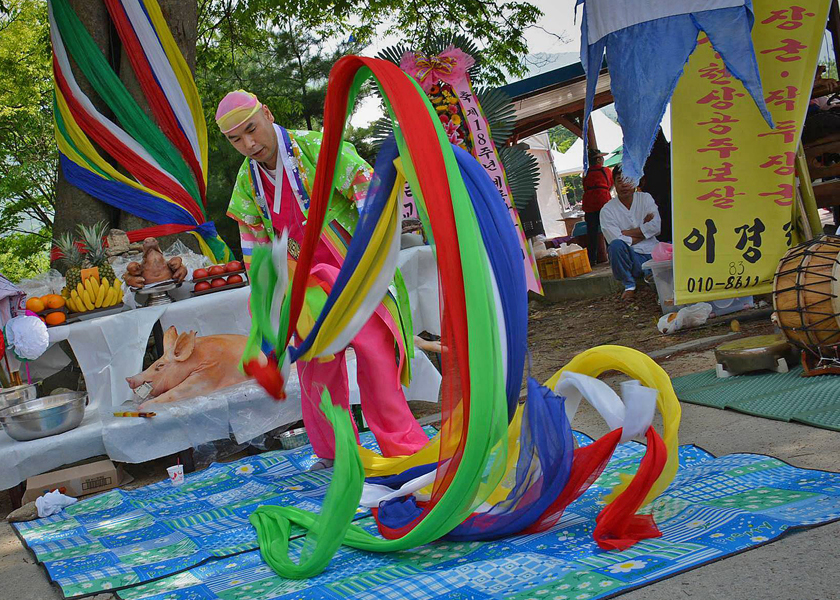
In mid-May, on a glorious spring day in Korea, I led a tour of a dozen shamanic shrines in the foothills of Gyeryong-san National Park, one of Korea’s most sacred areas.
The guests were Korean Quarterly’s staff photographer, a prominent Korean American shaman on a pilgrimage, and a Spanish graduate student studying Korean spiritual traditions and ceremonies.
As a historian in Korea, I have developed a specialty in the culture and art of Korea’s mountain places, particularly the places and art objects that venerate the sanshin, or mountain spirits of various places. This was a tour I was particularly interested in doing.

Gyeryong-san has been one of Korea’s most sacred mountains since ancient times. It has had various names and titles throughout Korean history. It was known as the central holy mountain of the Baekje Kingdom (approximately 18 BC to 660 CE). It was also known as the western peak of the Five Guardian Mountains (or O-ak) during the Unified Shilla (668 to 935 CE) and Goryeo Dynasties (918 to 1392 CE); and during the Joseon Dynasty (1392 to 1897 CE), it was known as the central peak of the same system.
The famous mountain is grand but actually not very high at all. The summit of the Heavenly King Peak (Cheonhwang-bong) is only 848 meters tall, but it is prominent on the west coast flatlands where few mountains top 1,000 meters. There are a half-dozen other main peaks, mostly with classical Buddhist names.
The word gyeryong-san means “Rooster-Dragon Mountain.” It is named for the way it looks. The main ridge, with about 20 sharp peaks, winds around like a dragon’s body, and resembles a cockscomb when viewed from a distance. Both the rooster and the dragon are symbolic animals in the Asian zodiac, which gives the name a deeper meaning. The gye word can also be read as “phoenix,” the firebird that is the mythological counterpart to the blue dragon. The alternate meaning, the “Dragon-Phoenix Mountain” has a profound yin-yang meaning.
The name Gyeryong may also have been derived from the myth of Alyeong, the first queen of the Shilla Kingdom, as told in the ancient text, the Samguk Yusa. The story is that when the founding king Bak Hyeok-geose was born, hatched from a giant egg found next to the Na-jeong Well, in Saryong village near sacred Mount Nam-san, the elders decided that a suitable wife needed to be found. On that day, in Saryang village, a strange rooster-dragon creature appeared, a gye-ryong. From its left side a girl was born. She was a beautiful child, but she had the beak of a chicken over her mouth.
The idea of the child being born from the side of its parent occurs throughout history. It is similar to the myth of Sakyamuni Buddha being born from his mother’s right side; and similar also to the Jewish myth of Eve being born from Adam’s side. The only problem linking this story with the mountain’s name is that the mountain is located very far away from the city of Gyeongju, and that in ancient times, Gyeongju was also the center of an enemy nation.
The mountain has retained its reputation as a sacred site through the ages. The renowned geomancer and prophet Doseon Guksa pronounced it to be a highly important spiritual place. Several dynasties attempted to build capitals in the vicinity of Gyeryeong-san, and religious people have always visited its sacred sites.

These days, Gyeryong-san is the most popular attraction in South Chungcheong Province. It is located just west of Daejeon City (a few kilometers southwest of the famous Yuseong Hot Spings District) and easily accessible from the expressways. In 1968, it became South Korea’s second national park, with 61 square kilometers of territory. There are three main ancient Buddhist temples in the park, including: Gap-sa , one of the oldest temples in Korea; Donghak-sa, the study-temple for female monks; and Shinwon-sa, which houses the largest and fanciest pre-modern sanshin-gak (worship hall for the mountain spirit) in Korea, and dozens of hermitages and shamanic shrines.

The rest of the park is crisscrossed with a dozen main hiking trails, often crowded. Three waterfalls grace the valleys, one in the center, two in the south (closed to the public) and the other on the northwestern end. The scenery at this place, combined with the significant cultural treasures, make it one of the best places in Korea to explore. Perhaps 100 spiritual sites are located on and around this one small mountain. Surrounding the park in every direction are many other traditional and modern cultural sites.
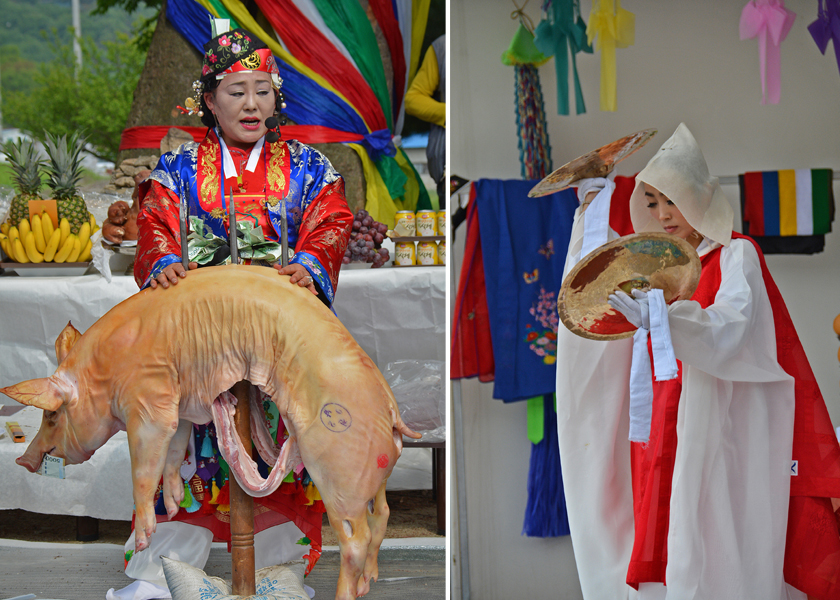
The goddess of Gyeryong-san, believed to be female and highly powerful, is venerated in this place, and named Cheonhwang-bong Seongmo-halmae San-shin. She is second in rank only to the matriarch goddess of Korea, who is associated with another mountain, Jiri-san, An annual weekend festival is held by a Gongju folk drama organization and the local government, timed with the third full moon of the year. The festival, held in the village near Shinwon-sa Temple (outside the park) features Buddhist, Daoist, neo-Confucian and shamanic ceremonies. This Gyeryong-san Sanshinje Mountain Spirit Ceremonial Festival is listed as an event on several internet sites, but only in Korean.

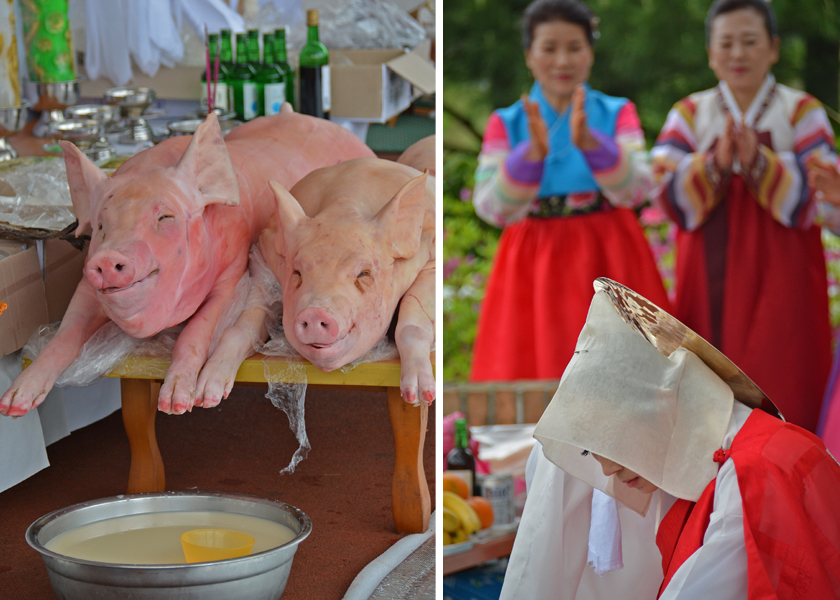
Shindo-an-gol (or the Spirit-Tao of Peace Valley) was traditionally the most sacred area of the mountain. This valley to the south of Heavenly King Summit, was planned to be the Goryeo Dynasty’s capital city (935 CE). In the Joseon Dynasty (1390 CE), the site was also chosen by pungsu-jiri (feng-shui) geomancers for that dynasty’s capital city. King Taejo Yi changed his mind and made Hanyang (later named Seoul) his new capital city, on the advice a geomancy expert.
This holy southern valley was taken over as the headquarters base of the Korean Army in the late 1970s, and is now closed to the public. The many shamans practicing there in centuries-old shrines were forced to move out, scattering to other areas near this prominent mountain.
Our group first visited Geumryong-am, the Golden Dragon Hermitage. This is a small but dramatically-sited Buddhist retreat house about a half-mile up a deep, narrow gorge behind Shinwon-sa. Behind the small temple is a waterfall gushing between boulders and plenty of exposed rock upon which a half-dozen shamanic altars stand. The waterfall is believed to be home to the Golden Dragon Spirit, and there is a Daoist hall in front of it enshrining that theme. There is a window above the empty main altar offering a view of the torrents. Its rear wall has a large mural of the Bodhisattva of Compassion riding cross-legged on, yes, a Golden Dragon.
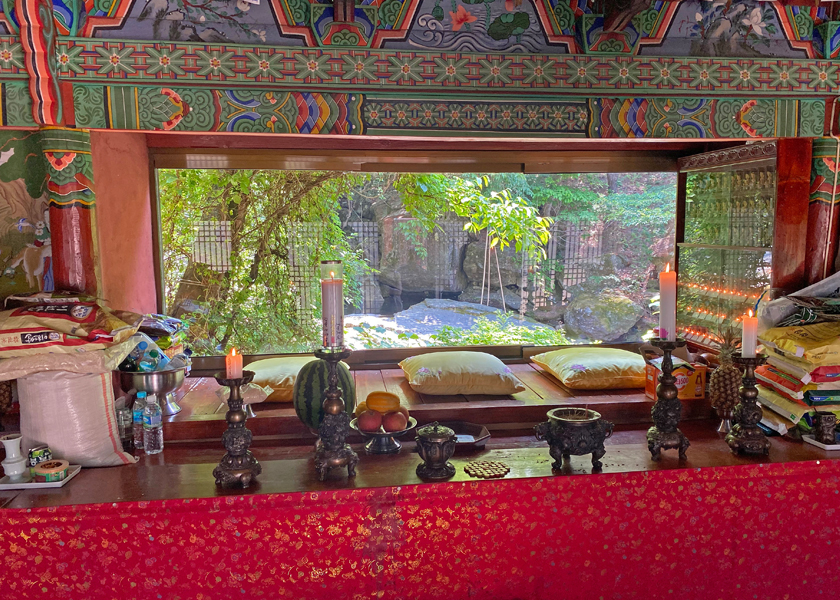

Shamanic dragon-worship activities are regularly conducted at these shrines. It is well-known as one of the most powerful sites within the shamanic community nationally, but virtually unknown to the general public, or to the international community.

Across from the Golden Dragon Hall is a sanshin shrine, featuring a unique mountain spirit painting. The painting depicts a husband-and-wife team of mountain spirits, each with their own two attendants and tiger (a third baby tiger is shown being fed by a tiny attendant!). There are interesting symbolic elements of this painting, including the yin-yang of the mother sanshin holding a ginseng root (yang) and leaf fan (eum in Korean, or yin) while the father sanshin holds a dragon-head staff (yang) and a certain mushroom signifying immortality (bullocho, considered to be eum or yin).
One tour participant, the Korean American shaman, posted afterwards on Facebook: “Another amazing spot on Gyeryong-san is the shrine for a golden manifestation of the Dragon King, Yongwang. The shrine looks out toward a sacred site where the Dragon spirit resides. This is the spot where I felt the most interesting energy throughout my visit. The Dragon King rules water, The Mountain God Sanshin rules land and is associated with the tiger. Although no physical tigers or dragons roam the land and sea, I felt their energetic presence.”
After that, we walked back down the forested road above the gorge, to historic Shinwon-sa (the Garden of the Spirits Temple), founded 1400 years ago; where I guided the group through its best features. On a large plateau to its rear stands the 250-year-old, authentic Royal Mountain Spirit Shrine that still venerates the “Central Peak of the Kingdom.” That shrine’s energy is oriented toward a hill to the east covered in magnificent mature hong sonamu (Korean red pine trees, or pinus densiflora), each one uniquely twisted and branched. The tree is known in Korea as the “king of all plants.”

It so happened that, on that day, the temple was beginning a baek-il-gido (a 100-day prayer ceremony) for Gyeryong-san’s spirit. The courtyard was filled with lay worshipers, and several monks were ritually chanting, accompanied by moktak hand drums. We admired the sanshin icon painting over the main altar, and the woodworking details of the old shrine.

Then we walked back to the national park entrance to get a great country-style lunch nearby. The woman who has run the hiker’s restaurant for decades is always friendly, and we enjoyed her delicious changguk-jang (a stew based on a fermented soybean preparation) and gong-guksu (cold noodles with a soymilk-based sauce].
After lunch, we crossed the stream on a rickety bridge and strolled through the village where the annual mountain spirit festival is held, and where there are good views of the holy mountain, then farther up the road where there are many modern shamanic shrines. We strolled from one to the next; I chose and explained the best ones I know of.


We spent four hours viewing eight sites, some openly shamanic shrines and other small temples which are outwardly Buddhist but with strong shamanic components. All the shrines are sited uniquely to fit into the natural landscape, and decorated with a variety of art depicting the various deities. I explained the significance of each work (the best I could) and we discussed the many motifs.
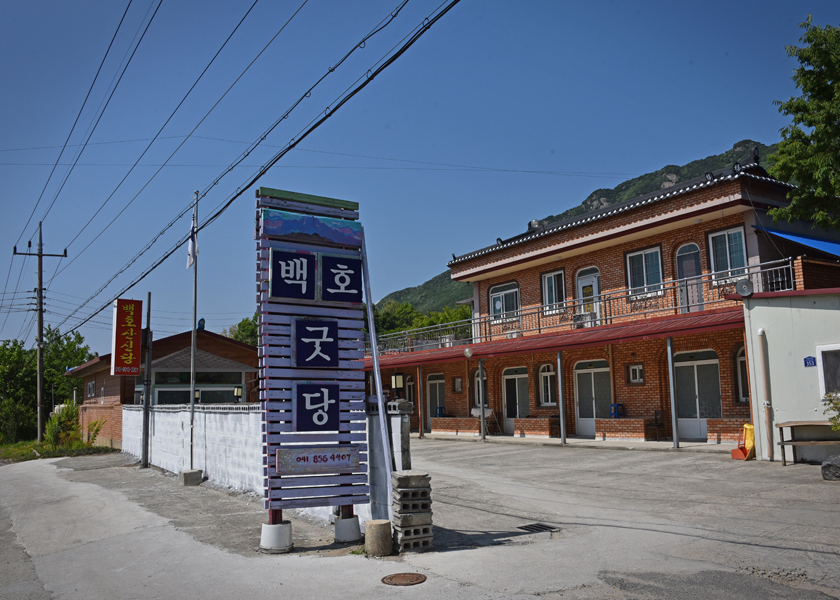

This is one of the very few areas in Korea where shamanism is fully legal, and is practiced openly. The mudangs (women shamans) at each one were very kind and welcoming to us. Few non-Koreans ever get to see places like this, and most Koreans don’t seek them out either.
As the shadows grew longer, we got a ride back to the KTX train station for our trip back to Seoul, with our sore feet and hundreds of rare photos. All agreed it was a great day.
The Korean American shaman posted afterwards on Facebook: “The images of the shaman shrines in Gyeryongsan mountain are vivid within my mind’s eye. The shrines built around natural rock formations are my favorite. One of the most powerful is the one without any anthropomorphic figures representing the mountain and ancestral spirits. What an amazing place! The energy of the land has fueled me to move to the next stage of my spiritual development. I’m hooked — I will return annually. David A. Mason, you’re an amazing resource! The mountain spirits are indeed pleased with your devotion. Thank you for sharing your knowledge.”

Author’s note: Recently retired cultural tourism professor, author, guide and longtime Korea resident David A. Mason will guide tours to these same shrines for individuals or private groups, and will also host some public tours available to anyone for a basic fee. The next public tour will be in November. Contact him on Facebook or at mtnwolf@gmail.com for details and reservations.


